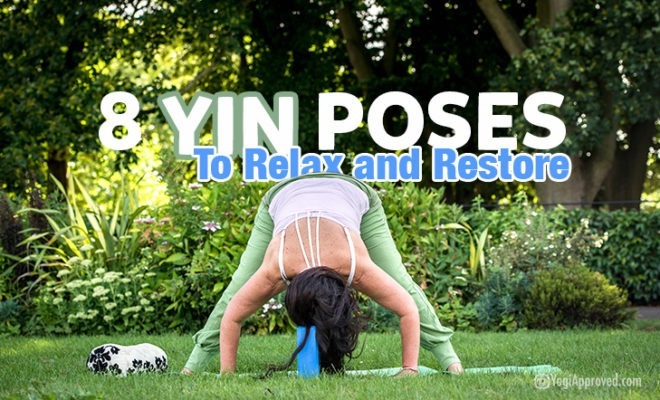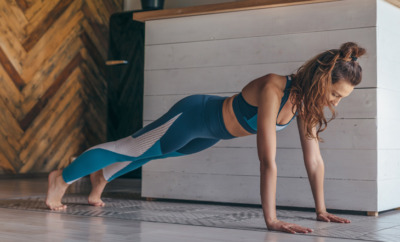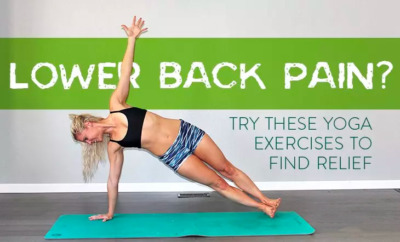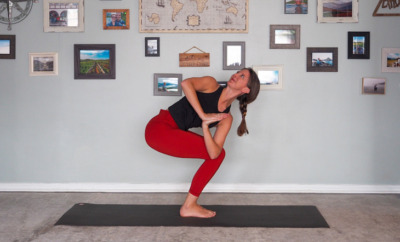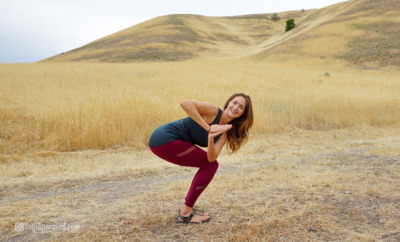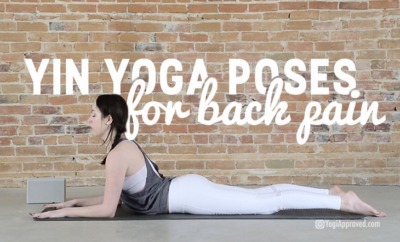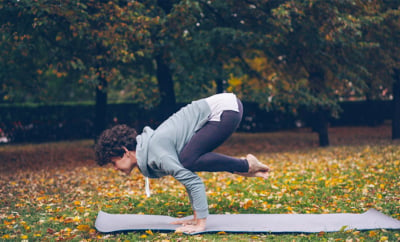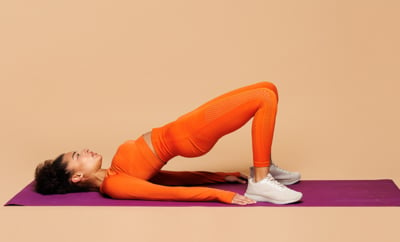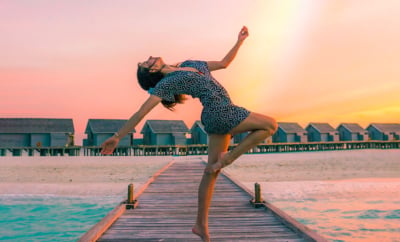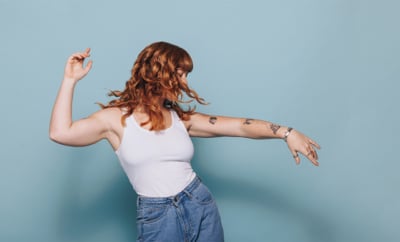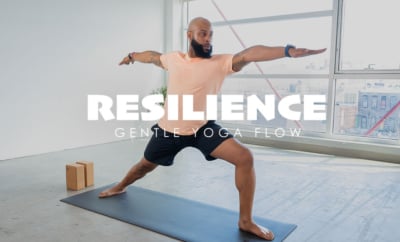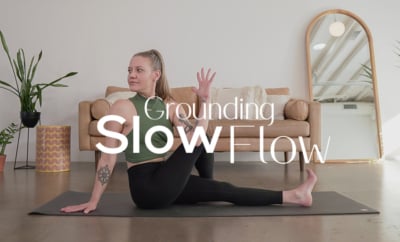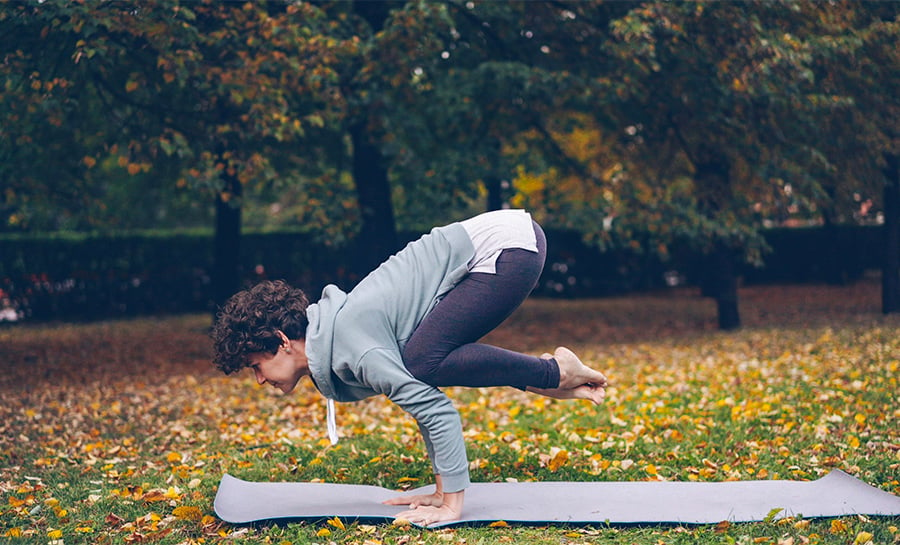Practice These 10 Yoga Poses to Correct Bad Posture

yoga poses for posture
They say that sitting is the new smoking because of all the negative impacts of a sedentary lifestyle. Yoga poses for bad posture are an effective way to counter the effects of habitual slumping and compression into the spine.
Sitting at a desk or computer all day takes a toll on more than just your eyes. It affects your posture, metabolism, risk of anxiety or depression and can lead to obesity, just to name a few . . .
If you want to strengthen your spine and improve your posture, read on to understand how a yoga practice can help correct your posture. We also share ten yoga poses for bad posture.
Bad Posture? Try This Online Yoga Class
How Yoga Can Help Improve Bad Posture
Bad posture can lead to serious issues like back pain, cardiovascular issues, digestion issues, and eventually changing of the curve of the spine itself, which will create a whole new level of back pain.
And those are only the physical effects of sitting! Studies have shown that slouching can change the way that others see you, is influenced by your mood such as depression, and can make you look heavier since your organs have nowhere to go but down.
Yoga is a fantastic way to combat the negative effects of sitting at a desk all day and other things that contribute to bad posture. Heart openers are the category of yoga poses that invert the hunched back and shoulders which is often a result from sitting too much.
So, in addition to straightening your posture, these chest opening poses will also help you open up emotionally, heal old wounds, be perceived in a better light, and embrace the world of abundance. Who doesn’t want that?!
Improve Your Spine: Practice These 10 Yoga Poses For Bad Posture:
You can practice these poses all together, or you can pick and choose what feels best in your body and what helps you most in correcting your posture. Practice these poses regularly, or any time you need a good stretch after sitting.
1. Heart Bench
Also referred to as Supported Fish Pose in Yin Yoga, this yoga pose for bad posture feels amazing – especially before bed, or after a long car ride. Relaxing and invigorating at the same time, once you are able to let go and sink into this supported posture, you won’t want to get out of it.
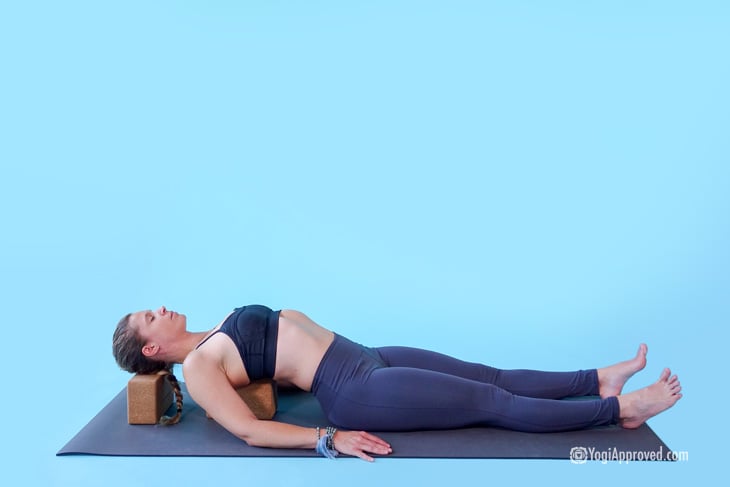
How to practice Heart Bench:
- For this pose, you will need two yoga blocks
- Set both blocks on the medium height like a “T” (you can also set the top block on the tallest height for more support)
- The long part of the “T” will rest between your shoulder blades and the top block that is the top of the “T” will hold your head
- Laying back on the blocks, there should be opening of the chest but no discomfort, so play around with where the longer block sits on your back to find that ‘sweet spot’
- Relax your entire body and pull your shoulders away from your ears as you rest your hands palms up by your sides
- Stay for 3-5 minutes
Did you love this pose?! Then you will LOVE this 17-Minute Restorative Yoga Sequence with yoga blocks!
2. Cow Face Arms
Cow Face Pose, or Gomukhasana, can be done any time, even while at your desk! It’s a fantastic stretch you can every day at the office or even when you’re sitting on the couch.
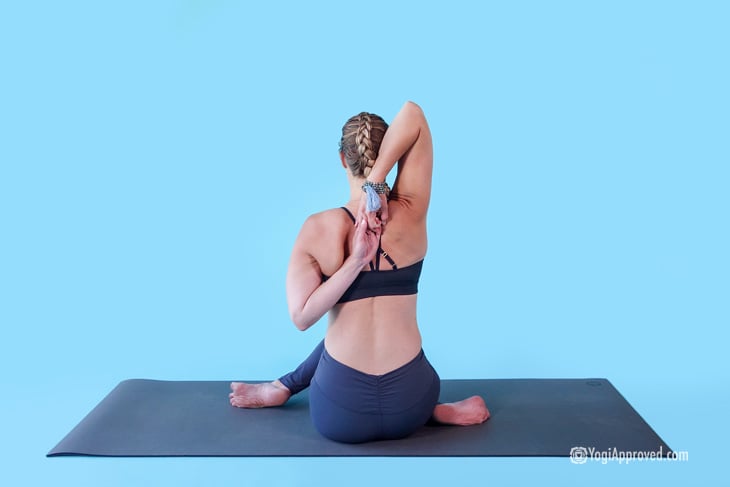
How to practice Cow Face Arms:
- If sitting in a chair, ground down through both feet. If sitting on the floor, find any comfortable seated position
- Lift the right arm skyward, then bend your elbow and reach your right fingers down your back
- Wrap the left arm behind your back, left fingers reaching up towards the right fingers
- Move the hands close to each other. If they touch, allow the right fingers to grab on to the left
- Can’t touch hands yet? No worries! Grab a yoga strap (or belt, scarf, etc) between the two hands
- Draw the elbows back and lift the chest. Breathe!
- Hold for 5 breaths and switch sides, lifting the left arm overhead and wrapping the right arm around and back
Want to explore more ways to incorporate a yoga strap in your practice? Check out 4 Ways to Deepen Your Practice With a Yoga Strap
3. Plank Pose
While Plank Pose is not a heart opener, it’s a core strength builder and core strength is a big part of good posture! This pose will keep you standing tall.

How to practice Plank Pose:
- Spread the fingers wide and bring your feet hip-width distance apart
- Press the floor away with the hands and keep all muscles of the legs active – thighs lifting the kneecaps and extending energy through the back heels
- Lift your hips to be in line with shoulders – don’t allow them to sink or sag towards the mat
- Keep the core active, drawing navel in towards spine and activating your Uddiyana Bandha, or Abdominal Lock
- Hold in 30 second intervals and option to add onto your time and work your way up to a full minute
Looking for more yoga tutorials and yoga tips? Check out our full library of Yoga articles here
4. Camel Pose
This deep back bend with undo all the hunching that happens when you sit at a computer or desk all day. Camel Pose, or Ustrasana, opens your heart, throat and shoulders.
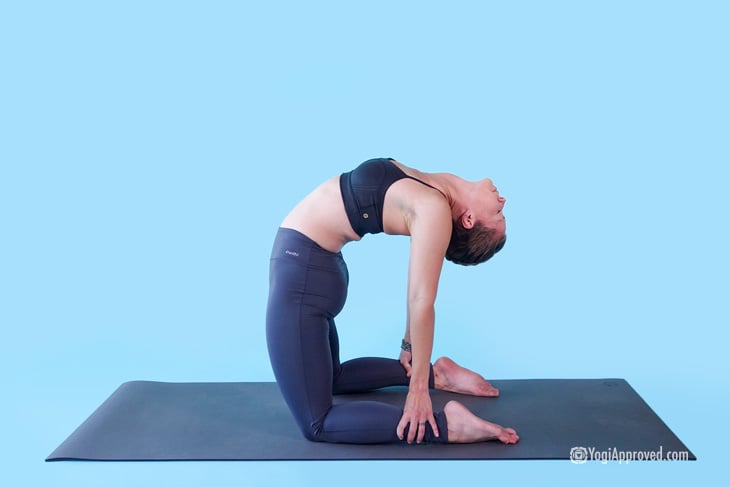
How to practice Camel Pose:
There are many variations for camel, so we will focus on the two most common variations. Both variations begin with the practitioner on their knees, toes tucked under, lengthening up through the crown.
- The first variation presses palms into lower back to protect the lumbar spine
- Press your hips forward, lift your heart, and send your gaze up while keeping the thighs active and the shoulders away from the ears
Hold for three breaths, then slowly come out - The second variation starts where the first variation ends and brings the backbend deeper by reaching back, one hand at a time, to grab the heels
- Keep those hips pressing forward and thighs active
- Hold for three more breaths
- After a few rounds of Camel, sit with a neutral spine for one breath and then fold forward to Child’s Pose to release the spine
5. Cobra Pose
Cobra Pose, or Bhujangasana, strengthens the arms while opening the upper back and shoulders and is an excellent yoga pose for bad posture.
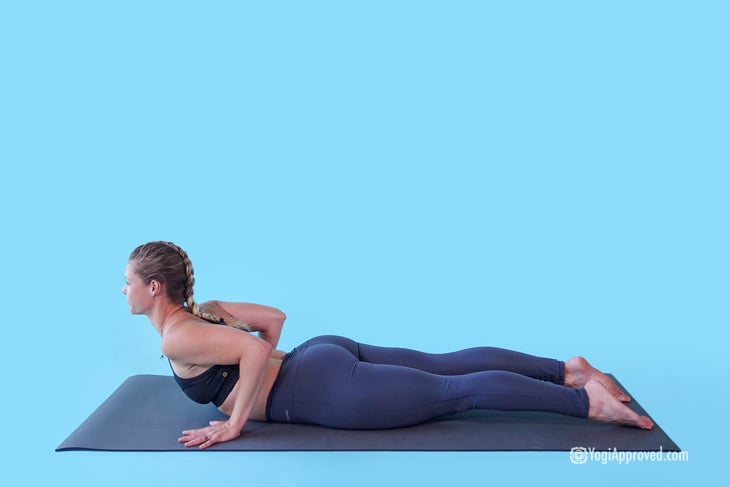
How to practice Cobra Pose:
- Laying on the belly, place your hands beneath the shoulders
- Spread the fingers wide and press down evenly to lift the head, neck and chest off the mat
- Squeeze the elbows in tight to the sidebody and slightly tuck the chin without putting any strain on the neck
- Hold for three to five breaths for two or three rounds
- Release and press back to Child’s Pose
Curious about Child’s Pose? Here’s everything you need to know
6. Wide Leg Forward Fold
For this variation of Wide Leg Forward Fold, or Pasarita Pattondandasana, you’ll interlace your fingers behind your back to open the shoulders and chest. Any variation of Wide Leg Forward Fold is a great way to lengthen the entire spinal column.
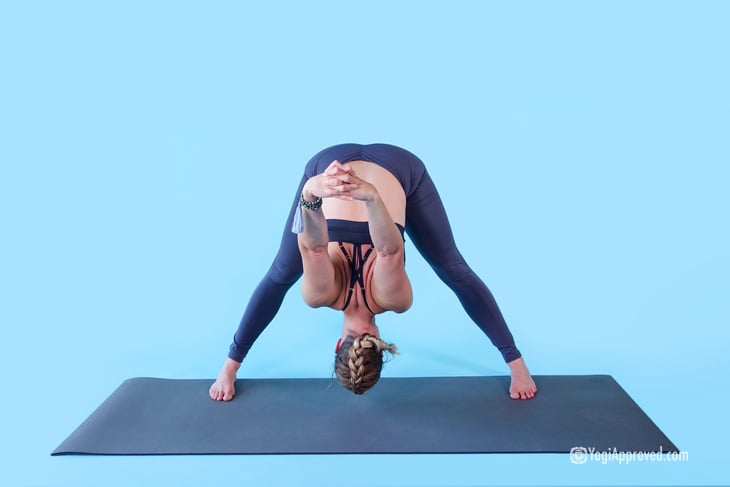
How to practice Wide Leg Forward Fold:
- From standing, heel toe your feet wider than hips distance apart – typically about four feet apart, the distance is based on what feels good in your body
- Interlace your fingers behind your back
- Inhale to lift the gaze and open the chest towards the ceiling, drawing the palms closer together
- On the exhale, fold forward and allow your arms to hang up and overhead
- If it is uncomfortable to keep your fingers interlaced, hold a yoga strap behind your back to create the same stretch but less intense
- Breathe here for 30 seconds
- Engage the core and inhale with a straight back to bring your body back to standing
7. Downward Facing Dog
Down Dog, or Adho Mukha Svanasana, is one of the first poses we learn in yoga, and it’s a powerhouse pose. Not only does Down Dog strengthen the arms, shoulders, and core; it also opens the hamstrings, back, chest, and shoulders.
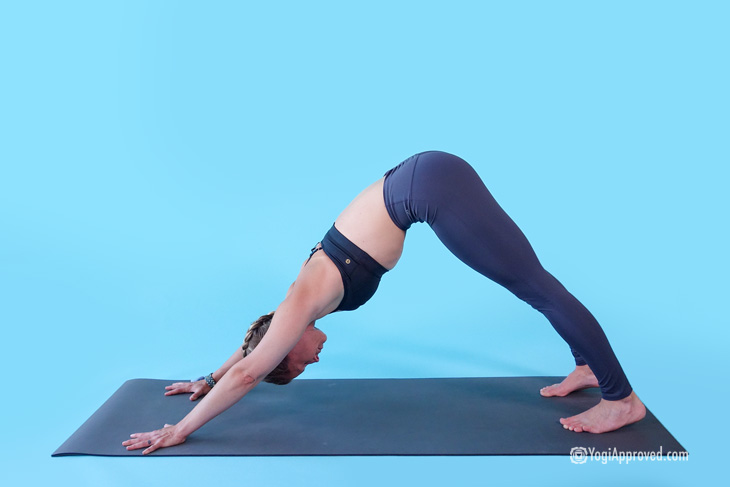
How to practice Downward Dog:
- From Plank Pose, press the hips up and back, and press your chest towards your chest
- Heels are hip-width distance apart and reaching down towards the mat (it doesn’t matter how close they get)
- Fingers are spread wide with weight evenly distributed through the hands
- Relax your head and neck, shoulders away from the ears, and send your gaze towards your toes
- Stay here for five breaths up to one full minute
Want a Down Dog tutorial? Check out How to Practice Down Dog Correctly
8. Bridge Pose
Bridge Pose, or Setu Bandha Sarvangasana, strengthens the lower body while it opens the spine and neck. Bridge Pose is a great backbend for all levels because you can choose how deeply to go based how you’re feeling that day.
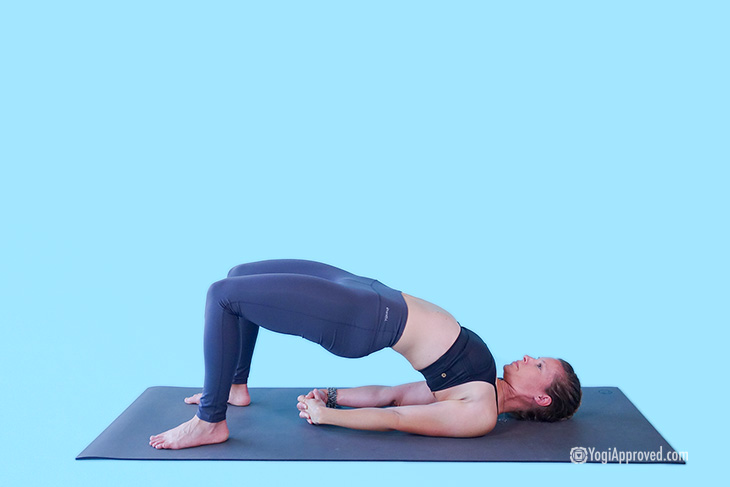
How to practice Bridge Pose:
- Laying on your back, palms face down at your sides, bring the soles of your feet to the mat with your knees up
- The feet should be close to the fingers and hips-width distance apart
- On an inhale, lift the hips to the sky while pressing down through the soles of the feet and the hands
- Stay here for three breaths
- Releasing on an exhale, lower down one vertebrae at a time
- For the second round, begin the same as the first. Inhaling the hips to the sky
- This time, option to clasp the hands behind your back and roll the shoulders underneath to get into a deeper backbend
- Breathe here for another three breaths before releasing on the exhale, one vertebrae at a time
- For the third round, repeat either of the first two options
- After three rounds, windshield wiper your knees back and forth to release any tension still in the spine
Check out this Beginner Backbends video for a full practice that helps open your heart and chest!
9. Bow Pose
Bow Pose, or Dhanurasana, is a very intense heart opener. When this yoga pose for bad posture is practiced properly, it feels amazing on your back and chest. Be sure that your body is warmed up for this.
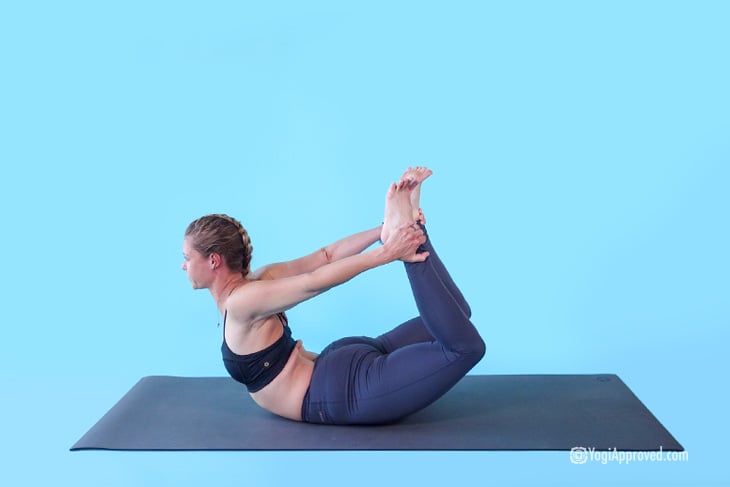
How to practice Bow Pose:
- Laying on your belly, bring your palms face down by your sides with the forehead or chin resting gently on the mat
- Bend the knees, drawing the feet towards your seat
- Reach back to grab the ankles, and make sure the knees don’t go wider than hips-width distance apart
- On an inhale, kick your ankles into your hands, roll your shoulders away from the ears, and lift chest and thighs simultaneously off the mat
- Breathe here for several breath
- When you release back down to the earth, relax for a breath or two before going into a second or third round
- When complete, press back into a wide legged Child’s Pose to release the spine
10. Supported Legs Up the Wall
Legs Up the Wall Pose, or Viparita Karani, is fantastic for stress, resets the spine, helps the heart effectively distribute blood throughout the body, and reduces any inflammation in the legs.
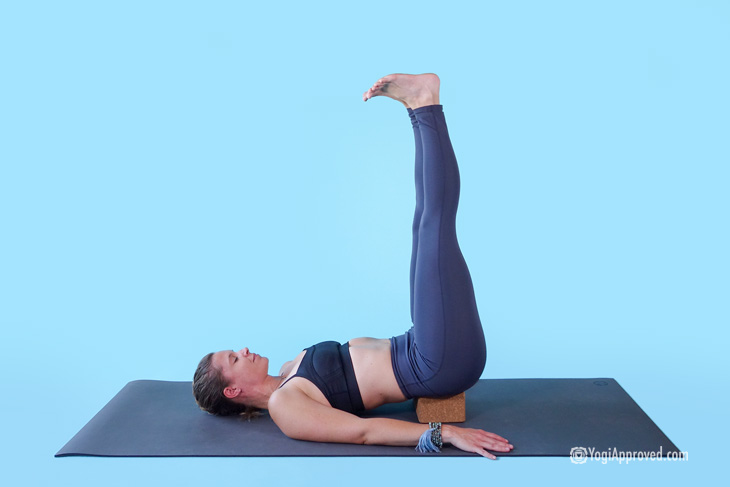
How to practice Legs Up the Wall:
- Sit with your side close against the wall
- Leaning back onto your hands, slide the back of your legs up the wall and recline onto your back with your feet facing the ceiling
- Make any small movements necessary to inch your seat closer to the wall, removing any space between
- From here, the hands can either rest on your belly or spread out to a “T” with palms facing up
- Close the eyes and relax
- Stay here for three to five minutes – enjoy!
Find Space In Your Spine with these Yoga Poses for Bad Posture
By strengthening and stretching the shoulders, chest, back, and abdominals (the areas affected by sitting all day), these yoga poses will help you stand taller, live with an open heart, and help to relieve any discomfort that comes with bad posture from sitting.
How do you feel after you’ve tried these poses for yourself? What’s your favorite feel-good stretch after a long day in the office? Let us know in the comments below!


This Month's Letter
From the Editor
Monthly motivation and food for
thought from our founder.

